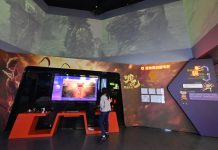BEIJING: Cultural heritage serves as a window into the traditions, culture and even the civilization of a country, so it is essential to intensify research efforts to enhance understanding of China’s cultural ethos and to promote mutual learning among Chinese and foreign civilizations, according to guests at a key cultural event.
They made the remarks at the International Communication Conference on Hongshan Culture and Vision China event on Saturday in Chaoyang, Liaoning province. Wang Xinwei, governor of Liaoning, said the province will take a series of measures to better protect, inherit and develop Hongshan culture, so that the precious cultural heritage can shine more brightly in the new era.
Hongshan culture, a key Neolithic culture dating from 6,500 to 5,000 years ago, spanned what is today’s Liaoning and Hebei provinces and the Inner Mongolia autonomous region. “We will enhance our commitment to the cultural mission in the new era, continuously deepen research on Hongshan culture, promote the application for World Heritage status of the Hongshan culture’s Niuheliang site in Chaoyang, Liaoning, and enhance the international understanding of Hongshan culture,” he said.
Under the theme “Tracing the Origins of Chinese Civilization: Focus on Hongshan Culture”, the activity brought together professionals in archaeological studies, cultural relics protection and civilization research, among others, to share their insights on Hongshan culture.
Qu Yingpu, publisher and editor-in-chief of China Daily, said: “The West Liaohe River Basin, together with the Yellow River and Yangtze River basins, is one of the important cradles of Chinese civilization. Among the many shining stars of early Chinese cultures, Hongshan stands out for its brilliance.”
Qu also said, “We must build a recognizable system of Chinese cultural symbols to help the world better understand China and the spiritual world of the Chinese people”, adding that modern technologies should be used to bring ancient stories to life.
Bao Xianhua, head of the Publicity Department of the Communist Party of China Inner Mongolia Autonomous Regional Committee, highlighted the cooperation between Liaoning and Inner Mongolia to deepen the understanding of Hongshan culture.
Inner Mongolia will continue to deepen cooperation with both Liaoning and Hebei, explore the multiple values of Hongshan culture, and promote the creative transformation and innovative development of fine traditional Chinese culture, he said.
Qiao Yunfei, deputy director of the National Cultural Heritage Administration, called for continued efforts to explore the pivotal role of Hongshan culture in the origins and development of Chinese civilization, open museums and archaeological-site parks related to it, and build Hongshan culture into a symbol of Chinese civilization with global influence. –The Daily Mail-China Daily news exchange item






